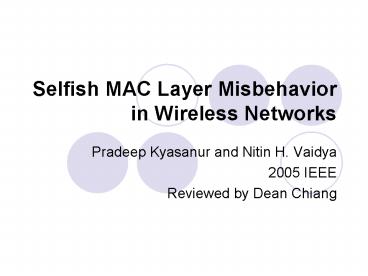Selfish MAC Layer Misbehavior in Wireless Networks - PowerPoint PPT Presentation
1 / 18
Title:
Selfish MAC Layer Misbehavior in Wireless Networks
Description:
Selfish MAC Layer Misbehavior in Wireless Networks. Pradeep Kyasanur and Nitin H. Vaidya ... PC319a.jpg. http://images.belkin.com/F6D3000/PRN1_F6D3000.jpg ... – PowerPoint PPT presentation
Number of Views:157
Avg rating:3.0/5.0
Title: Selfish MAC Layer Misbehavior in Wireless Networks
1
Selfish MAC Layer Misbehavior in Wireless Networks
- Pradeep Kyasanur and Nitin H. Vaidya
- 2005 IEEE
- Reviewed by Dean Chiang
2
How is network contention resolved?
- Distributed Contention Function (DCF)
- Relies on protocol adherence from all of the
network.
Ok everyone better wait the same amount!
Im transmitting guys!
What if I dont want to?
You got it!
3
Problem Definition
Normal Host Backoff rand0,CW
t
Normal Channel Usage
t
Channel Usage with a Selfish Host
4
Problem Challenges
- Difference between a small backoff and differing
usage by each node? - Node channel conditions are different. A node
can claim an idle channel.
5
Solution
- Modified MAC Protocol
- Goal retain performance of 802.11 while ensuring
detection of misbehavior in a short interval - Assumptions
- Misbehaving senders only. Receivers are assumed
to be trusted. - No collusion between sender and receiver
6
Protocol Modifications - Backoff
- Receiver assigns random backoff and sends it in
the CTS and ACK. Receiver is in control.
7
Protocol Modifications - Retransmission
- Sender adds attempt number to RTS
- Receiver estimates expected backoff from attempt
number.
8
Penalty Scheme
- Penalize if
- B_actual lt Alpha B_expected (Alpha 0.8)
- Penalty
- Add to next backoff by an amount proportional to
deviation and then some. - Still not adhering? Identify as a selfish host.
(Last W packets that deviated over total
threshold T slots) - Receiver is in control. Misbehavior with backoff
cannot be spoofed by senders.
9
What happens after identification?
- Possibilities
- MAC Layer
- Receiver exiles sender by not responding to RTS.
- Network Layer
- Network routes around host.
10
Misdiagnosis
- Receiver senses a busy channel from 2 hops away
when sender does not. - Sender sends to receiver, receiver thinks sender
did not adhere to assigned backoff. - Solution receiver does not count a busy channel
for transmission, only during overheard RTS/CTS.
11
Results Diagnostic Accuracy
- Notes
- Low misdiagnosis rate
- Does not fully resolve selfish behavior problem.
Only alleviates high end of deviation. - Notice there is a threshold of misbehavior that
can go undetected.
12
Results Throughput
- Throughput comparison to 802.11
- Adheres closely to throughput of 802.11
13
Results Fairness
- Fairness Index comparison to 802.11
- Fairness decreases with of nodes
- Fairness deviates more when background traffic is
high (TWO-FLOW)
14
Results What about crafty clients?
Correct Diagnosis Protocol is worse at
detecting adaptive misbehavior
HOWEVER
Throughput gain is not large because of penalty
scheme
15
Pros and Cons
- Pros
- Fast diagnosis, no need to collect tons of data
- Low Misdiagnosis rate
- Retains fairness and throughput of 802.11
- Reduces workaround potential
- Cons
- Additional overhead
- Backwards compatibility
- Spoofed MAC addresses
16
Addendum Optimal Threshold
- Authors show a proof for an optimal threshold
- Threshold T is a function of assigned back-off
value and of slots. - However, authors chose a static threshold in
simulations. This suggests the data could be
better.
17
Discussion/Consideration
- What does the police do?
- Why did the government create a police force?
- At what intrinsic layer does the governments
control end?
http//www.thunderroadlaser.com/images/thunderimag
es/05_Police20Badge20-2072dpi.jpg
18
Discussion/Consideration
- Is this really the best place to handle selfish
behavior?
Base Station
PC, Driver
Wireless Network Adapter
Not Regulated by IEEE
Regulated by IEEE
Regulated by IEEE
http//images.belkin.com/F6D3000/PRN1_F6D3000.jpg
http//compuplus.com.mx/tienda/images/WAP54G.jpg
http//store.madtux.org/images/PC319a.jpg

